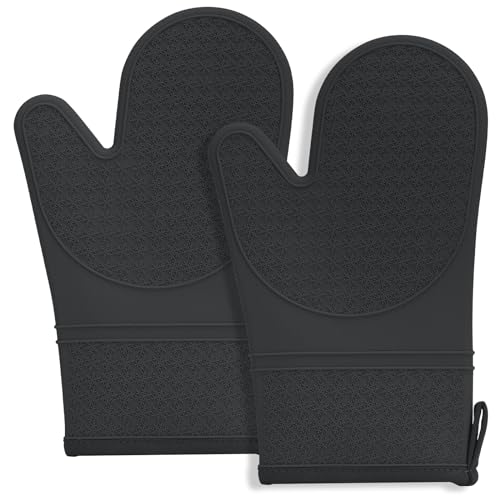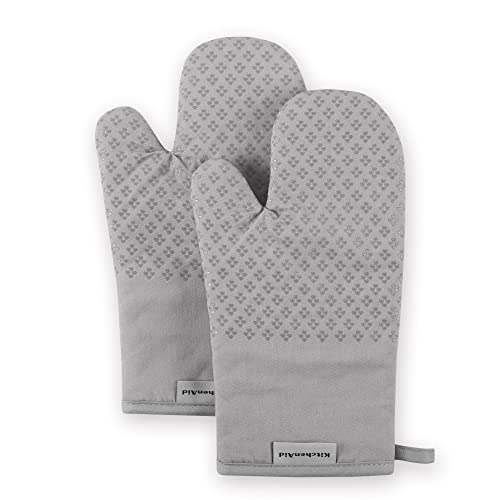Best Oven Mitts Reviews: An Expert Guide
Ready to handle hot dishes with ease and safety? Dive into our comprehensive best oven mitts reviews! We've sifted through the options to bring you the top contenders known for their heat resistance, comfort, and durability. Say goodbye to burnt fingers and hello to culinary confidence as we explore the perfect oven mitts to suit your kitchen needs. Let's ensure your hands are protected in style while you cook up a storm!
Compare Products
- KR Score9.6
Kitchensradar.com established a ranking system called KR Score. KR Score is unaffected or unrelated to any websites run by manufacturers or sales agents. Learn more
- BrandGorilla Grip
- KR Score9.4
Kitchensradar.com established a ranking system called KR Score. KR Score is unaffected or unrelated to any websites run by manufacturers or sales agents. Learn more
- BrandHovico
- KR Score9.4
Kitchensradar.com established a ranking system called KR Score. KR Score is unaffected or unrelated to any websites run by manufacturers or sales agents. Learn more
- Brandrorecay
- KR Score9.4
Kitchensradar.com established a ranking system called KR Score. KR Score is unaffected or unrelated to any websites run by manufacturers or sales agents. Learn more
- BrandKEGOUU
- KR Score9.4
Kitchensradar.com established a ranking system called KR Score. KR Score is unaffected or unrelated to any websites run by manufacturers or sales agents. Learn more
- Brandsungwoo
- KR Score9.4
Kitchensradar.com established a ranking system called KR Score. KR Score is unaffected or unrelated to any websites run by manufacturers or sales agents. Learn more
- BrandKitchenAid
- KR Score9.4
Kitchensradar.com established a ranking system called KR Score. KR Score is unaffected or unrelated to any websites run by manufacturers or sales agents. Learn more
- BrandIXO
- KR Score9.4
Kitchensradar.com established a ranking system called KR Score. KR Score is unaffected or unrelated to any websites run by manufacturers or sales agents. Learn more
- BrandKitchenAid
- KR Score9.2
Kitchensradar.com established a ranking system called KR Score. KR Score is unaffected or unrelated to any websites run by manufacturers or sales agents. Learn more
- BrandOXO
- KR Score9.2
Kitchensradar.com established a ranking system called KR Score. KR Score is unaffected or unrelated to any websites run by manufacturers or sales agents. Learn more
- BrandHvalucen
Last update on 2024-08-20 / Affiliate links / Images, Product Titles, and Product Highlights from Amazon Product Advertising API
While some chefs may choose to use oven mitts, many professional chefs prefer oven gloves or other specialized heat-resistant hand protection for several reasons:
- Dexterity: Oven mitts can be bulky and limit finger movement, making it challenging to handle delicate or intricate tasks in the kitchen. Chefs often require precise control and dexterity when handling hot pots, pans, and utensils, which gloves may provide more effectively.
- Heat Protection: Oven gloves typically offer full hand and wrist coverage, providing better protection against burns and heat exposure compared to mitts, which leave the wrists exposed. This additional coverage can be crucial in busy kitchen environments where chefs are constantly moving around hot equipment and open flames.
- Hygiene: Oven gloves are often easier to clean and maintain compared to mitts, which can trap moisture and food particles inside their fabric. Gloves made from materials like silicone or neoprene can be washed or wiped clean more efficiently, reducing the risk of cross-contamination in the kitchen.
- Comfort: Oven gloves may offer better comfort and breathability, especially during extended periods of use in hot kitchen environments. The flexibility and lightweight construction of gloves can contribute to a more comfortable and ergonomic experience for chefs and kitchen staff.
What are the disadvantages of oven mitts?
While oven mitts offer some level of heat protection and insulation for the hands, they also have some disadvantages compared to other types of heat-resistant hand protection:
- Limited Dexterity: Oven mitts can restrict finger movement and limit the chef's ability to grasp and manipulate objects with precision, which may be necessary for certain cooking tasks.
- Limited Coverage: Traditional oven mitts typically cover only the fingers, palm, and back of the hand, leaving the wrists exposed to potential burns or heat exposure.
- Bulkiness: Mitts can be bulky and cumbersome to wear, particularly when handling small or delicate items in the kitchen. The thickness of the material may also make it difficult to grasp objects securely.
- Hygiene Concerns: Fabric oven mitts can absorb moisture, grease, and food particles, which can harbor bacteria and lead to hygiene issues if not cleaned regularly. Additionally, fabric mitts may stain or retain odors over time, affecting their appearance and functionality.
Which type of oven gloves are best?
The best type of oven gloves depends on individual preferences, cooking habits, and specific needs in the kitchen. Some popular types of oven gloves include:
- Silicone Oven Gloves: Silicone gloves offer excellent heat resistance, flexibility, and grip, making them ideal for handling hot pots, pans, and grill grates. They are waterproof, easy to clean, and durable, providing long-lasting protection in the kitchen.
- Neoprene Oven Gloves: Neoprene gloves are heat-resistant, lightweight, and flexible, providing comfortable hand protection for a variety of cooking tasks. They offer good dexterity and insulation, making them suitable for handling hot dishes, baking trays, and utensils.
- Kevlar Oven Gloves: Kevlar gloves are highly heat-resistant and cut-resistant, offering superior protection against burns, cuts, and abrasions in the kitchen. They are often used in professional kitchens and industrial settings where safety is a top priority.
- Oven Mitts with Separate Fingers: Some oven mitts feature individual finger compartments or a mitten design with separate thumb and finger sections, offering better dexterity and control compared to traditional mitts. These mitts provide more flexibility and allow chefs to grip and handle objects more easily.
What is the difference between oven mitts and oven gloves?
The primary difference between oven mitts and oven gloves lies in their design and construction:
- Oven Mitts: Oven mitts are padded fabric mittens that cover the fingers, palm, and back of the hand, providing heat protection when handling hot dishes, pans, or oven racks. They typically have a thumb compartment and are worn by sliding the hand into the mitt.
- Oven Gloves: Oven gloves are heat-resistant gloves that cover the entire hand and wrist, offering full coverage and protection against burns and heat exposure. They are usually made from materials like silicone, neoprene, or Kevlar and are designed to provide better dexterity and grip compared to mitts. Gloves may have individual finger compartments or a mitten-style design with separate thumb and finger sections.
Are mitts better than gloves?
Whether mitts are better than gloves depends on individual preferences, cooking habits, and specific needs in the kitchen. Mitts offer some advantages, such as simplicity, ease of use, and familiarity, but they also have limitations, including restricted finger movement and limited coverage. Gloves, on the other hand, provide full hand and wrist protection, better dexterity, and versatility for handling various cooking tasks. Ultimately, the choice between mitts and gloves comes down to personal comfort, functionality, and the demands of the cooking environment.
Related Posts:
The Best Oven Gloves, Every Budget
10 Best Kitchen Hot Pads, Ranked By Experts
Best Potholder For Every Budget
Best Oven Mitts Cooks Illustrated For Beginners 2024




























